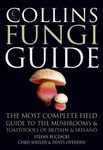About this book
The genus Togninia (Diaporthales, Togniniaceae) is here monographed along with its Phaeoacremonium (Pm.) anamorphs. Ten species of Togninia and 22 species of Phaeoacremonium are treated. Several new species of Togninia (T.) are described, namely T. argentinensis (anamorph Pm. argentinense), T. austroafricana (anamorph Pm. austroafricanum), T. krajdenii, T. parasitica, T. rubrigena and T. viticola. New species of Phaeoacremonium include Pm. novae-zealandiae (teleomorph T. novae-zealandiae), Pm. iranianum, Pm. sphinctrophorum and Pm. theobromatis. Species can be identified based on their cultural and morphological characters, supported by DNA data derived from partial sequences of the actin and β-tubulin genes. Phylogenies of the SSU and LSU rRNA genes were used to determine whether Togninia has more affinity with the Calosphaeriales or the Diaporthales. The results confirmed that Togninia had a higher affinity to the Diaporthales than the Calosphaeriales. Examination of type specimens revealed that T. cornicola, T. vasculosa, T. rhododendri, T. minima var. timidula and T. villosa, were not members of Togninia. The new combinations Calosphaeria cornicola, Calosphaeria rhododendri, Calosphaeria transversa, Calosphaeria tumidula, Calosphaeria vasculosa and Jattaea villosa are proposed.
Species of Phaeoacremonium are known vascular plant pathogens causing wilting and dieback of woody plants. The most prominent diseases in which they are involved are Petri disease and esca, which occur on grapevines and are caused by a complex of fungi, often including multiple species of Phaeoacremonium. Various Phaeoacremonium species are opportunistic fungi on humans and cause phaeohyphomycosis. The correct and rapid identification of Phaeoacremonium species is important to facilitate the understanding of their involvement in plant as well as human disease. A rapid identification method was developed for the 22 species of Phaeacremonium. It involved the use of 23 species-specific primers, including 20 primers targeting the β-tubulin gene and three targeting the actin gene. These primers can be used in 14 multiplex reactions. Additionally, a multiple-entry electronic key based on morphological, cultural and β-tubulin sequence data was developed to facilitate phenotypic and sequence-based species identification of the different Phaeoacremonium species. Separate dichotomous keys are provided for the identification of the Togninia and Phaeoacremonium species. Keys for the identification of Phaeoacremonium-like fungi and the genera related to Togninia are also provided.
The mating strategy of several Togninia species was investigated with ascospores obtained from fertile perithecia produced in vitro. Togninia argentinensis and T. novae-zealandiae have homothallic mating systems, whereas T. austroafricana, T. krajdenii, T. minima, T. parasitica, T. rubrigena and T. viticola were heterothallic.
Taxonomic novelties: Calosphaeria rhododendri (Rehm) L. Mostert comb. nov., C. transversa (Sacc. & Farim.) L. Mostert comb. nov., Jattaea villosa (Nitschke) L. Mostert comb. nov., Phaeoacremonium iranianum L. Mostert, Gräf., W. Gams & Crous sp. nov., Pm. sphinctrophorum L. Mostert, Summerb. & Crous sp. nov., Pm. theobromatis L. Mostert, H.C. Evans, Summerb. & Crous sp. nov., Togninia argentinensis L. Mostert, W. Gams & Crous sp. nov. (anamorph Pm. argentinense L. Mostert, W. Gams & Crous sp. nov.), T. austroafricana L. Mostert, W. Gams & Crous sp nov. (anamorph Pm. austroafricanum L. Mostert, W. Gams & Crous sp. nov.), T. krajdenii L. Mostert, W. Gams & Crous sp. nov., Pm. novae-zealandiae L. Mostert, W. Gams & Crous sp. nov., T. parasitica L. Mostert, W. Gams & Crous sp. nov., T. rubrigena L. Mostert, W. Gams & Crous sp. nov., T. viticola L. Mostert, W. Gams & Crous sp. nov.
Customer Reviews





































